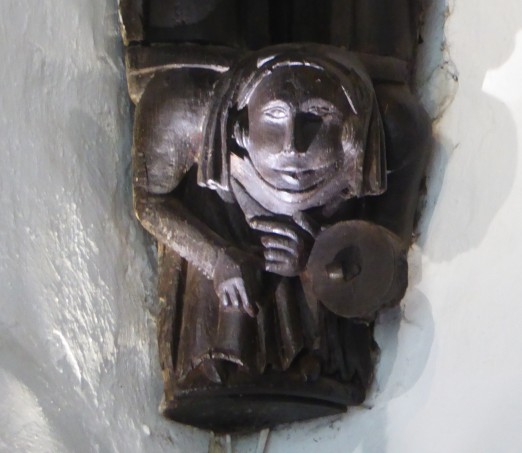This week really will be much shorter because firstly I’m going to mention a lecture organised by History at CCCU next Thursday 13 December, and then will report on one event. The lecture at 5pm in Newton, Nf09 will be given by Dr Neil Murphy of the University of Northumbria and his chosen topic is, ‘Cartography, Colonisation and Henry VIII’s Conquest of Boulogne, 1544-6’ – all welcome.
On Wednesday we had the last meeting for 2018 of the Kent History Postgraduates. Those attending were the Centre’s stalwarts: Janet Clayton, Lily Hawker-Yates and Dean Irwin, and we also welcomed back Jacie Cole. Those living further away, such as Rebecca Jarvis, were unable to be there, but we had our two postgraduate speakers from west Kent, Maureen McLeod and Jane Richardson, both of whom are finishing their first term as part-time doctoral students.
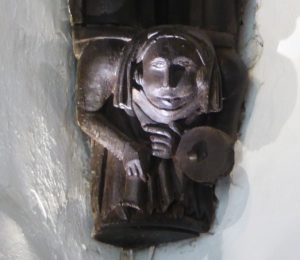
Early 14th century carving, Great Hall at Ightham Mote
The first presentation was given by Maureen on the deer parks of Tonbridge. She started by exploring how the Lowry of Tonbridge had come into being – formed from the dens of various manors in the vicinity by King William I, who having built a castle to defend the river crossing, had given the castle and Lowry to the de Clare family. Consequently, the estate was largely oak and beech woodland for pannage, with the growing settlement of Tonbridge at its centre.
In England, such woodland might be royal forest and subject to forest law or chases and under the common law, neither of which was enclosed although the boundaries were known. In contrast, deer parks were designated areas and enclosed using high fences – deer can leap surprisingly high barriers! As you might expect because of the cost of fencing, deer parks were far smaller than either royal forests or chases. Other expenses linked to parks were labour and feedstuff for the deer in winter, albeit the deer might be fed in the chases in winter, which may also have helped to keep them within the area because they were free to wander across the chase boundary.
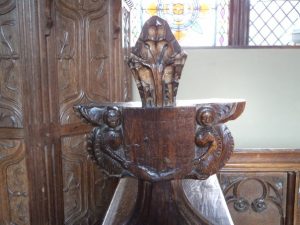
Bench end, New Chapel at Ightham Mote
Maureen has become increasing interested in deer management and the roles played by these parks, and she mentioned the doctoral work of Dr Susan Pittman (Canterbury Christ Church) on the Kent deer parks in the early modern period. To this should be added Dr Amanda Richardson’s work on medieval forests, deer parks and hunting. She then discussed the various uses these deer parks might be put beyond the obvious, and that such leisure pursuits might include coursing – driving the game passed a ‘stand’ from which the hunters could shoot the animals with arrows. In addition to fallow deer (only a few red deer), the two Tonbridge chases of North Frith (about 4,000 acres) and South Frith (about 5,000 acres) included rabbit warrens, thereby requiring the services of a warrener as well. Probably also hunted were herons and boar, while Postern (one of the two Tonbridge deer parks at about 800 acres) contained a fishery, a vital resource in a society that placed so much emphasis on fish days within the liturgical year.
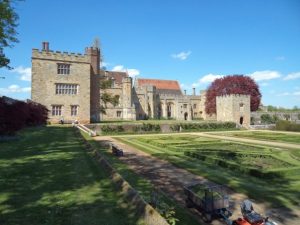
Penshurst – the importance of lay lordship in the Weald, west Kent
For the de Clare family and their successors at Tonbridge, their chases and deer parks were valuable for leisure, as ways to exercise patronage through, for example, the giving of gifts of venison, as a means to gain status, as sources of timber and firewood, and as sources of other revenue, including the grazing of pigs, cattle and sheep – at different times of year. Furthermore, iron smelting would become increasingly important in the area, especially in the later 16th and 17th centuries. Thus, as Maureen concluded, these areas were employed in a variety of ways and were valuable assets, albeit their presence in the landscape could and did raise certain problems, such as a rise in social tensions at times, these hunting grounds were an inefficient use of land and did restrict development of the neighbourhood.
Her presentation sparked considerable discussion and, as Janet Clayton observed, her own work on north-west Kent, specifically Scadbury, would offer a fruitful comparison to Jane’s Tonbridge study.
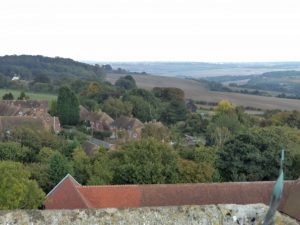
From Cobham church roof
This brought us on to Jane’s presentation. She too is investigating aspects of Tonbridge’s history, in her case Cardinal Wolsey’s dissolution of three religious houses in the area: Tonbridge, Lesnes and Bayham, with other monasteries nationwide so that he could found his Cardinal’s College. However, she is presently examining the evidence surrounding foundation of these religious houses, and her presentation was on the problems of trying to discover whether Tonbridge was established c.1140 or c.1180. This bit of detective work will take Jane to the Bodleian. Her initial research stemmed from 18th and 19th century drawings, the 1838 tithe map, a late 19th-century article in Archaeologia Cantiana, documents in Registrum Roffense (edited in 1769), a scale model of the last surviving building made in 1840, and an article in Historical Research by Professor Cheney. Together these brought her to the printed calendar produced by Turner and Coxe regarding charters held in the Bodleian Library. However, as she explained, the calendar at Oxford is heavily annotated concerning the Tonbridge Priory archive. Consequently, as Jane explained, if the annotations are Cheney’s this would imply that the priory was founded late in the 12th century, and that this was only a few years before the papal bull issued in 1192 which confirmed the priory’s foundation charter. This later date has implications regarding assessing the early history of these Augustinian canons and Jane is intending to visit Oxford soon to look at both the calendar and the charters.
Jane’s paper similarly produced a lively discussion about sources, their reliability and why specific documents were produced – matters of production and reception. Thus, her audience will look forward to her next presentation where hopefully more will be revealed about the early history of this priory.
 Centre for Kent History and Heritage
Centre for Kent History and Heritage Sheila Sweetinburgh
Sheila Sweetinburgh 1691
1691